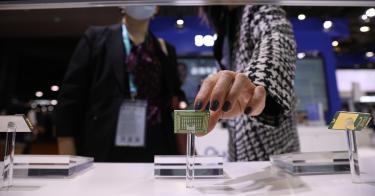China’s largest chipmaker, SMIC, has acquired advanced semiconductor technology and is now producing 7-nanometer chips. It’s a big leap forward, but it’s important to keep the development in some perspective.
Beijing is pursuing several strategies to lessen its dependence on foreign technology. And when it comes to boosting domestic production of critical semiconductor chips, no company is more important than SMIC.
But Washington has refused to play ball—at least at the highest levels of technology. Concerned about China’s increasingly aggressive behavior and how that threatens both regional stability and national security, the U.S. has been pushing back against Beijing’s broader strategic ambitions for several years.
In 2020, a few months after security concerns led the Trump administration to prohibit U.S. producers from selling chips to Huawei, the Commerce Department placed restrictions on sales to SMIC. Like Huawei, SMIC has close relations with People’s Liberation Army. Its chips are essential to China’s military development and build-up. To confine Beijing’s burgeoning military capacity, Washington deemed it necessary to control exports to SMIC.
>>> CHIPS Is a Missed Opportunity for Real Security
The restrictions placed on U.S. suppliers of certain types of equipment sought by SMIC were later amplified when Washington successfully encouraged the Dutch company ASML, a global leader in the chip-making process known as EUV lithography, not to sell its chip-making equipment to SMIC.
These export restrictions have not yet hampered SMIC’s sales and operations. According to SMIC’s latest financial statement, first quarter revenues this year were 67% higher than last year’s.
The strong global demand for semiconductor chips has helped SMIC weather the U.S. export restrictions. Despite the lack of cutting-edge technology, SMIC chips are used in a variety of electronic devices, such as smartphones, vehicles, 4G transceiver, navigation devices and biomedical devices. Key clients include China’s HiSilicon, America’s Qualcomm, and Sweden’s Fingerprint Cards.
Clearly, Beijing is pushing its domestic market to “buy SMIC.” In Q1 2022, customers in China and Hong Kong accounted for 68% of SMIC’s total sales revenue, compared to only 56% in Q1 2021. Sales shares from all other regions declined during the same period. And SMIC is actively working with Shenzhen and Beijing to increase its chip production capacity.
While U.S. export restrictions have not damaged SMIC’s profitability, they have hindered the company’s efforts to advance its level of technology. Unable to freely import equipment for making advanced (below 10-nanometer node) chips, the company is stuck with using older technology. In 2021, chips made with technology more than 10 years old accounted for 85% of its sales revenue. Without access to foreign equipment, it will be very difficult for China to produce the most advanced chips any time soon, putting a severe crimp in Beijing’s plans for its military and security apparatus.
Last month’s announcement regarding 7-nm technology does not change this. SMIC might be able to produce 7-nm with its existing technology, but without the use of EUV lithography, the chips will be more costly to make, and their quality will be questionable. With the continued ban of EUV exports, SMIC is unlikely to be able to reach mass production and expand the global market share of high-tech chips in the foreseeable future.
While huge in China, SMIC is a relatively small player in the global chip market. In the global foundry business, Taiwan’s TSMC dominates, with 56% of market share compared to SMIC’s 4%. Taiwanese firms are particularly dominant in cutting edge (below 10-nm) logic production, accounting for 92% of global market share in 2019.
Tellingly, SMIC and all other Chinese semiconductor companies combined cannot come close to keeping up with China’s domestic demand for chips. They accounted for only 6% of total chips sold in the country in 2020.
As a global factory for manufactured goods, China needs a tremendous number of chips. Its reliance on foreign-made chips has created an enormous trade deficit in integrated circuits and electronic components: $216 billion in 2020, according to the World Trade Organization.
>>> China More Dependent on U.S. and Our Technology Than You Think
U.S. export restrictions have also contributed to another headache for China: Taiwanese executives leaving SMIC. China has actively recruited Taiwanese semiconductor talent for several years. The impossibility of procuring advanced chip-making equipment has deeply darkened the outlook for China’s semiconductor industry. Taiwanese executives have recognized this and are leaving for greener pastures. Growing political tensions between China and the West, not to mention Beijing’s increasingly threatening behavior toward Taiwan, has only exacerbated the exodus of executives.
SMIC can continue to turn a profit using older technology. But, without partnerships and technology transfer from the U.S. and others, it will be very challenging for any Chinese company to become a truly major player in the global semiconductor industry… or help the Red Army make the great leaps forward it envisions. As Chinese companies are eased out of international supply chain networks, it will be increasingly difficult for any of them to replace TSMC in the foundry business, ASML in producing lithography machines or Qualcomm and Broadcom in designing chips.
China might still be able to reach its aim of lifting the domestic content of core component and material from less than 10% in 2015 to 70% in 2025. But to get there under current constraints, most of the gains would come from foreign manufacturers in China, not Chinese companies. And there, the U.S. has leverage too… if it plays its cards right.
Export controls on products sought by SMIC and Huawei have thrown a monkey wrench in several of Beijing’s grand strategies. Continued targeted, strategic manipulation of key nodes in tech supply chains, including in semiconductors, has the potential to constrain China’s most dangerous ambitions for years to come. SMIC’s most recent breakthrough, however, serves as a warning that development can come in unanticipated ways.
This piece originally appeared in RealClear World



